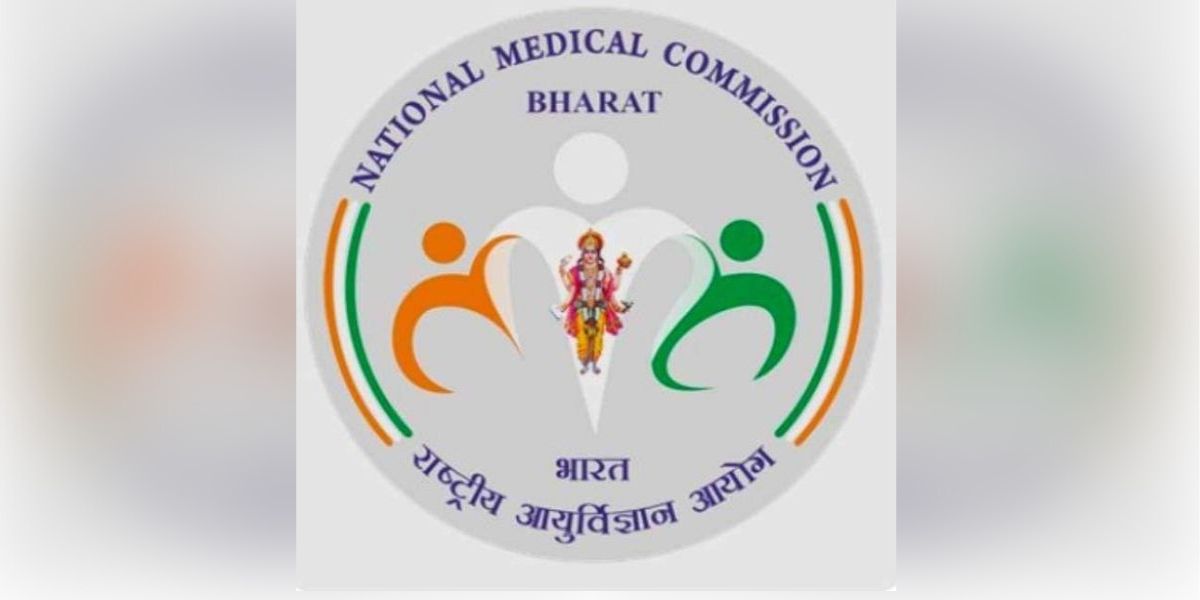The NMC logo, with a coloured image of physician god Dhanvantari in the centre, has drawn criticism from doctors and public.
Published Dec 12, 2023 | 3:55 PM ⚊ Updated Dec 12, 2023 | 4:06 PM

All rounds of counselling for all PG seats will be held online mode by state or central counselling authorities.
Even after the Indian Medical Association (IMA), the largest organisation of doctors in the country, opposed the new logo of the National Medical Commission (NMC), the Union government has defended the change in the logo to feature Dhanvantari — the physician of the gods in Hindu mythology — instead of a secular emblem.
It justified its decision and said that it was part of India’s heritage and everyone must feel proud of it.
The logo of the NMC, with a colourful image of physician god Dhanvantari in the centre, has drawn criticism from doctors, with the IMA urging the apex medical education regulator to take “corrective steps”.
“The logo of any national institution ought to capture the aspirations of all our citizens in an equal manner and by remaining neutral in all respects thereby eliminating any possibility of any part or section of the society feeling aggrieved in any manner,” the IMA said in a letter.
When Trinamool Congress’ (TMC) Santanu Sen, who is a past national president and state secretary of IMA, raised the issue of the change in the logo during Zero Hour in the Rajya Sabha on Monday, 11 December, Health Minister Mansukh Mandaviya said that Dhanvantari is a symbol of Indian medical science.
.@SantanuSenMP #ZeroHour mention in #RajyaSabha on the demand of the medical fraternity to restore the previous logo of the #NationalMedicalCommission#ParliamentOfIndiahttps://t.co/R3Yx4JjDjH
— AITC in Parliament (@AITC_Parliament) December 11, 2023
“(It was) already a part of the (Commission’s) logo and just some colour has been added and nothing more,” he said.
“This is India’s heritage. I feel we should feel proud (about it),” he added. The minister said that the logo is designed by taking inspiration from the country’s heritage.
“This is a symbol of medical science…someone who had done so much research in medical science. We have used the photo with no other intention,” he stated.
Before the NMC came into existence, the highest medical education regulatory body was the Medical Council of India (MCI). Following an amendment in 2020, the MCI was replaced with the NMC.
The MCI was adopted in 1934 after the Indian Medical Council Act, 1933, was enacted. This Act was repealed by the Indian Medical Council Act, 1956, which was itself repealed in 2020 when the NMC came into existence.
The MCI’s logo was based on the international symbol for medicine — the staff of Asclepius, the Greek god of medicine and healing. The logo also featured a snake wound around the staff.
While there has been no official announcement of a change in the NMC’s logo, a black and white logo with the depiction of Dhanvantari at the centre reportedly appeared only in December 2022. The colourised version appeared a few months later.
Raising the issue through a Zero Hour mention, Sen demanded the restoration of the NMC’s previous logo. He said that the Indian Medical Council Act of 1956 was repealed in 2020, despite objections from different sections of society and the medical fraternity.
Earlier, it was termed as “Western medicine”, then it became “medicine” and finally it has been termed as “modern medicine”, Sen said, and added that the logo of modern medicine is the staff of Asclepius.
“There was no need and there was no permissible condition, so far as the National Medical Commission is concerned, that this logo can be changed. But, unfortunately, we have seen in the recent past, I don’t know (if it is) because of government instruction or by the National Medical Commission itself, they have changed the logo and they have brought a photograph of Dhanvantari in the logo,” Sen said.
“Change of logo was absolutely not needed. It symbolises one particular religion,” he added.
The National Medical Commission, he said, regulates medical curriculum and sanctions new medical colleges. “Its function is not to promote any particular religion. Even the Ayush Department did not change its logo but the National Medical Commission has,” the TMC MP charged.
“It is against the basic oath which doctors take after passing MBBS. They take the oath that we will treat each and every patient irrespective of their caste, creed, or religion. We are not bound to treat one particular religion,” he recalled.
The change of logo, Sen said, was against the basic essence of the Indian Constitution which, through Article 25 and 26 after the 42nd Amendment in 1976, states that India is a secular country.
He demanded that the NMC immediately restore the previous logo that did not symbolise any particular religion.
After alterations to the logo came to light last month, the IMA expressed concern, stating that it ran counter to the “fundamental values” upheld by doctors. Dr Sharad Agarwal, President of the IMA, in a letter to the Union Health Ministry, said that doctors pledge to provide care to everyone regardless of their caste, class, or religion.
Consequently, he questioned the appropriateness of having a religious affiliation in the logo of an institution responsible for doctor training.
“While doctors are free to practice their faith in their personal lives, institutions should maintain a secular stance. I urged the NMC to prioritise enhancing the quality of medical education in the country rather than engaging in controversies,” he said.
Dr Agarwal concluded by calling on the NMC to rectify the situation by adopting a logo that aligns with the impartiality expected in the oath and duty of doctors toward all citizens, without any association with a particular religion.
